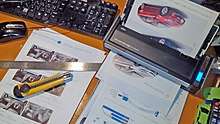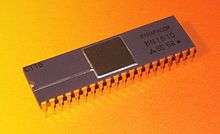PFU Limited
PFU Limited (株式会社PFU, Kabushiki gaisha Pī Efu Yū) is a Japanese information technology company. The company was formed by the merger of Panafacom and USAC Electronic Industrial in 1987.
Native name | 株式会社PFU |
|---|---|
| Subsidiary of Fujitsu | |
| Industry | Information Technology |
| Founded | 1960 as Unoke Electronic Industrial |
| Headquarters | Kahoku, Ishikawa, Japan |
| Revenue | ¥135,200 million (2018[1]) |
| Owner | Fujitsu |
| Members | 4,403 (2019[1]) |
| Website | www |
As of 2019, PFU focuses on computing and IT consulting. Its product line includes image scanners, embedded computers and professional computer keyboards (Happy Hacking Keyboard).[1]
The company owns a volleyball team, PFU BlueCats, formed in 1979 at USAC Electronic Industrial.
History
Panafacom was a conglomerate of the Japanese companies—formed by Fujitsu, Fuji Electric and the Matsushita Group on July 2, 1973. The company provided OEM manufacturing for Fujitsu and Matsushita, and developed one of the first commercially available 16-bit microprocessors, the MN1610.[2][3][4]
Unoke Electronic Industrial (合名会社ウノケ電子工業, Gōmei gaisha Unoke Denshi Kōgyō) was a minicomputer manufacturer founded on November 1, 1960. Uchida Yoko became a distributor of its minicomputers to enter the computer business. Unoke Electronic Industrial was renamed to USAC Electronic Industrial (ユーザック電子工業株式会社, Yūzakku Denshi Kōgyō Kabushiki kaisha) in 1969.
Fujitsu, Uchida Yoko and USAC Electronic Industrial began a partnership in 1971. Panafacom merged with USAC Electronic Industrial to create PFU in 1987.[5] PFU became to be a wholly owned subsidiary of Fujitsu in 2010.[6]
Products
Image scanner

Fujitsu spun off image scanner product lines to PFU in 2001. PFU (under Fujitsu brand) has more than 50% share of the worldwide enterprise image scanner market.[7]
Keyboard
The Happy Hacking Keyboard is a small computer keyboard codeveloped with Japanese computer engineer Eiti Wada, manufactured by Fujitsu Takamisawa Component Limited, and debut in 1996. It was expensive to enter the American OEM market, so PFU released the Happy Hacking Keyboard Lite which was manufactured by Chicony Electronics. It failed to sell in the United States, but was successful in Japan. In 2003, Fujitsu Takamisawa Component would stop production of keyboards in Japan, so PFU codeveloped the Happy Hacking Keyboard Professional with Topre Corporation. The series shipped 400,000 units as of 2015.[8][9]
Minicomputer
Panafacom had developed minicomputers for Fujitsu since 1973.[10] When the company was founded, 70% of staff were engineers who developed minicomputers at Fujitsu.[11] USAC Electronic Industrial had also developed minicomputers for Uchida Yoko and Fujitsu.
Microcomputer

In April 1975, Panafacom announced the 16-bit single-chip microprocessor, the Panafacom L-16A (MN1610).[12]
NEC released the TK-80 microcomputer evaluation kit in 1976, and it became popular among computer enthusiasts and hobbyists in Japan. Panafacom also released the Panafacom Lkit-16 in March 1977 to popularize the MN1610.[13]
The Panafacom C-15 is an industrial personal computer using the MN1610 processor, announced in Japan in May 1978.[14] It cost ¥700,000 (equivalent to ¥1,066,232 in 2019) with 16 KB of RAM, flat keyboard, monochrome display and cassette tape recorder.[15]
The Panafacom C-180 is an office personal computer announced in 1980. It has two MN1610A processors clocked at 4 MHz, 124 KB of RAM, 80×24 text, two 320 KB 5 1⁄4 inch floppy drives and Japanese keyboard. Its price was ¥1,650,000 (equivalent to ¥2,246,308 in 2019)[16] At first, it was provided only to OEMs. Hoya Glass purchased 1,500 of C-180 from Fujitsu to introduce computer terminals at its eyeglass stores.[17] In October 1981, Fujitsu sold it as the FACOM 9450, Matsushita sold it as the C-18, and Panafacom began selling it. Its price was started at ¥790,000 (equivalent to ¥1,025,049 in 2019) for a configuration with 128 KB of RAM, two 640 KB 5 1⁄4 inch floppy drives, monochrome display and keyboard. While Panafacom marketed it as a standalone system, Fujitsu marketed it as a network workstation. Getting popular of the IBM 5550 which had a similar concept, the FACOM 9450 also got popular in the corporate sector.[18]
The Panafacom C-280 was announced in 1983. It has two MN1613 processors, 384 KB of RAM and 640×480 pixel resolution. Fujitsu sold it as the FACOM 9450II, Matsushita sold it as the Operate 7000, and Honeywell Japan sold it as the DPS Junior.[19]
The Panafacom C-380 was announced in 1985. It has an MN1617 processor, a 68000 as a display controller, an HD63484 CRTC, 1 MB of RAM and 960×720 pixel resolution.[20] Fujitsu sold it as the FACOM 9450Σ, and Matsushita sold it as the Operate 8000.
By 1988, Fujitsu sold 250,000 units of the FACOM 9450 series, and it was followed by the FMR series.[21]
References
- "会社情報 | プロフィール | PFU". PFU. Retrieved 2019-11-02.
- "16-bit Microprocessors". CPU Museum. Retrieved 5 October 2010.
- "History". PFU. Retrieved 5 October 2010.
- "Panafacom 1613 Processors". Ukcpu.net. Retrieved 5 October 2010.
- "PFU History". Fujisoft Archives. Retrieved 27 April 2018.
- "富士通、PFUを完全子会社化". ITmedia NEWS (in Japanese). 2010-02-01. Retrieved 2019-11-02.
- 山口, 真弘 (2014-02-01). "PFU「ProDeSセンター」見学記". PC Watch (in Japanese). Impress Corporation. Retrieved 2019-11-02.
- 劉, 尭 (2016-11-24). "偶然が重なり合って生まれ、紆余曲折を経たHHKBの20年". PC Watch (in Japanese). Impress Corporation. Retrieved 2019-11-02.
- 関根, 慎一 (2017-10-02). "「HHKB 20周年記念ユーザーミートアップ」イベントレポート HHKBのこれまでとこれからを開発者とヘビーユーザーがとことん語らう特濃イベント". AKIBA PC Hotline! (in Japanese). Impress Corporation. Retrieved 2019-11-03.
- Information Processing Society of Japan. "FACOM (PANAFACOM) U-200 and PANAFACOM U-100 Series". IPSJ Computer Museum. Retrieved 27 April 2018.
- "企業研究:ミニコン・メーカーからパソコン・メーカーへと変貌するパナファコム". コンピュートピア (in Japanese). コンピュータ・エージ社. 17 (7): 116–119. July 1983. ISSN 0010-4906.
- Yamada, Akihiko (2014). "パーソナルコンピュータ技術の系統化調査" (PDF) (PDF) (in Japanese). National Museum of Nature and Science. p. 267. Retrieved 2019-11-02.
- Information Processing Society of Japan. "PANAFACOM Lkit-16". IPSJ Computer Museum. Retrieved 27 April 2018.
- "パーソナルコンに進出。パナファコム、産業向け専用機。". Nikkei Sangyo Shimbun (in Japanese). 1978-05-12. p. 4.
- "PANAFACOM C-15". www.canomate.com (in Japanese). Retrieved 2019-11-01.
- "New Product Focus: 多目的パーソナル・コンピュータ C-180". Interface (in Japanese). CQ Publishing. 6 (12): 206–209. 1980. ISSN 0387-9569.
- "パナファコム OEM向け パソコン市場に進出 3500台を受注". 日本情報産業新聞 (in Japanese). 1980-09-29. p. 1.
- "勝負ついた?ビジネスパソコン商戦(上) 日本IBM・富士通・日電リード。". Nikkei Sangyo Shimbun (in Japanese). 1985-06-23. p. 4.
- "日本ハネウェル、パソコンに参入―パナファコムから機器をOEM調達し7月発売。". Nihon Keizai Shimbun (in Japanese). 1983-07-01. p. 10.
- "NEレポート:グラフィック機能を強化した960x720画素のビットマップ・ディスプレイ付き16ビット・パソコン". Nikkei Electronics (in Japanese). Nikkei McGraw-Hill: 145–147. 17 June 1985. OCLC 5530170.
- "富士通がパソコン、9450シリーズをFMRに統合。". Nihon Keizai Shimbun. 1988-10-26. p. 11.